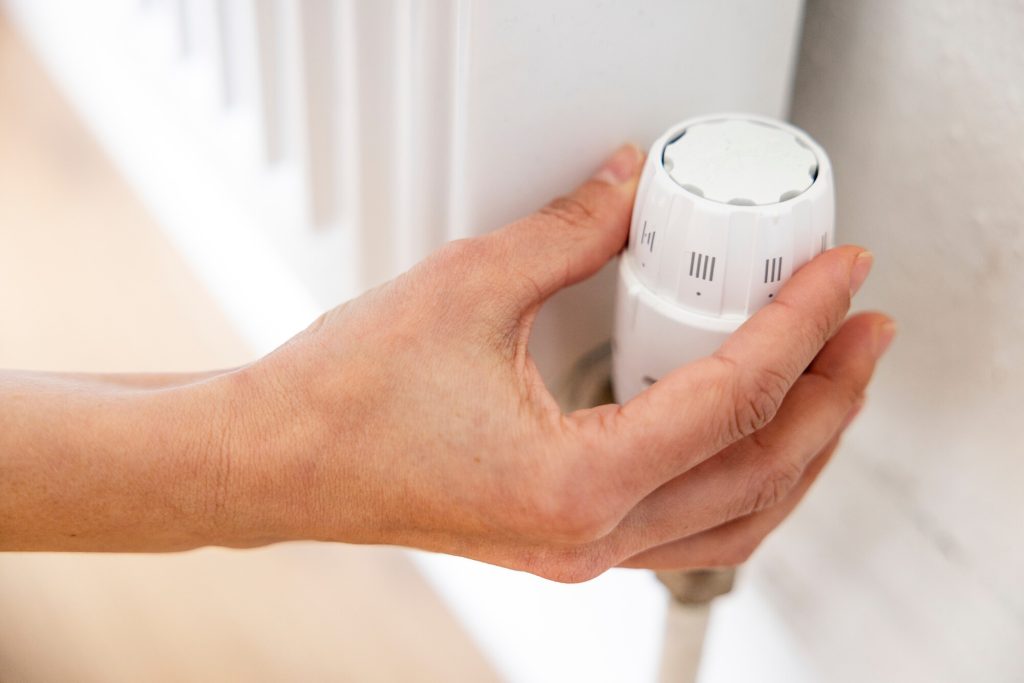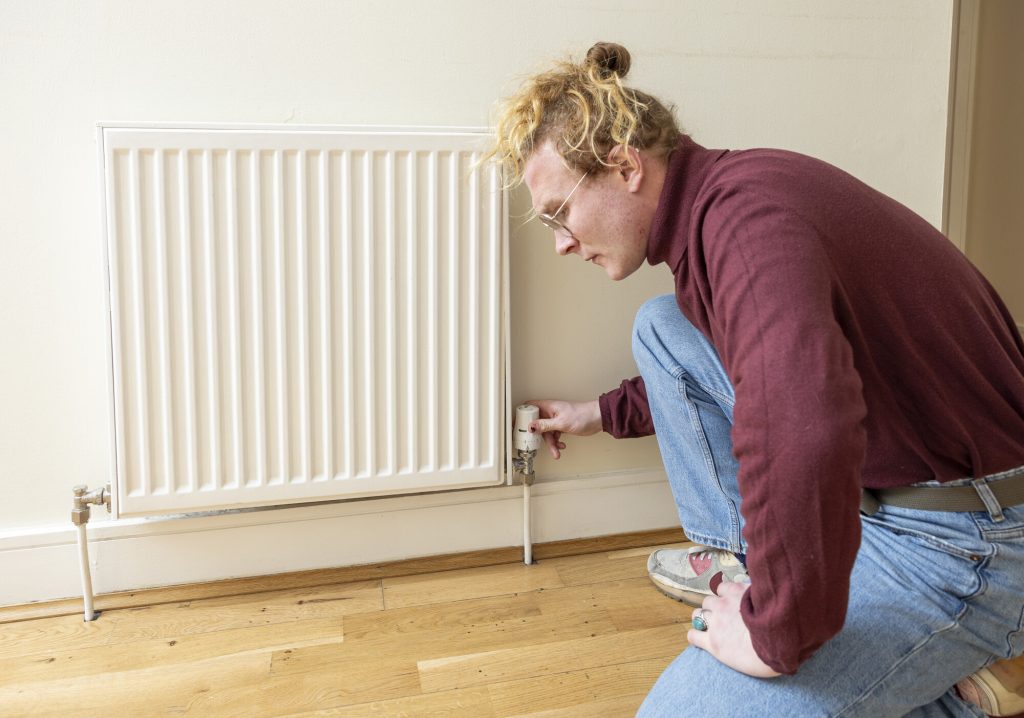How do radiators work?

Radiators are the end point in a central heating system. Your boiler heats water and sends it to the radiators, causing them to heat up. As a result, the radiators heat up the surrounding air, warming our home.
As with other parts of your central heating system, getting control of your radiators lets you stay warm whilst saving money.
Understanding how radiators work
A radiator’s temperature is controlled by valves. Turning the valves changes how much hot water flows through the radiator. If a lot of hot water flows in, the radiator will get hot. If only a little hot water flows in, the radiator will get warm, but not hot.
There are three types of valves that let you change a radiator’s temperature:
- Manual radiator valve
- Thermostatic Radiator Valve (TRV)
- Smart Thermostatic Radiator Valve (Smart TRV)
All radiators also have a lockshield valve. This has a different job, which we’ll look at below.
Radiator lockshield valve
A radiator lockshield valve controls:
- how much water is sent back to the boiler
- how much water is sent to the next radiator
It’s important that enough water flows to the next radiator. If it doesn’t, the radiators furthest away from your boiler won’t ever get as hot as you want them.
The lockshield valve is usually at the bottom-left or right of a radiator. It’s got a cap on it which is quite difficult to turn. This means you can’t accidentally change the flow of water.
Manual radiator valves
A manual radiator valve will be on the opposite side to the lockshield valve. You should be able to twist it quite easily.
Many manual radiator valves have + and – signs on them. This helps you work out which way to turn them when adjusting the temperature. Turning towards the + opens the valve and lets more hot water in. Turning to the – does the opposite.
Thermostatic Radiator Valves (TRVs)
Thermostatic Radiator Valves (TRVs) are a popular replacement for manual radiator valves. They give you much more control over your heating.
TRVs have numbers instead of + and – signs. These numbers give you a better idea of how hot your radiator will get. A TRV is usually numbered 0-5. 0 is the off setting, 5 is the highest.
Each TRV has a sensor that reads the air temperature around it. This is exactly like the sensor on an oven. When you set a TRV to a number, it will keep the room at a temperature based on that number. It does this by changing how much hot water it lets into the radiator.
The numbers on a TRV don’t give you an exact temperature. Each number covers a range of about five degrees. For example, setting a TRV to 2 will give you a temperature between about 15 and 20 degrees.

You can see how the numbers relate to temperatures below:
0 = 0°C (off)
✱ or ● = 7°C
1 = 10°C
2 = 15°C
3 = 20°C
4 = 25°C
5 = 30°C
Smart TRVs
Smart TRVs are the next generation of TRVs. They give you greater control over your heating, with better accuracy and more features than classic TRVs.
A Smart TRV lets you set the temperature of each radiator in degrees. As we’ve seen, each number on a classic TRV represents a range of different temperatures. With a Smart TRV, there’s no more guesswork. 20 degrees means 20 degrees.
You can use an app (on your phone or computer) to set a programme for your Smart TRVs. This means each individual room can have its own heating schedule, matched to your routine.
Money-saving tips for using your radiators
Whichever type of radiator valves you have, you can save money on your heating bill.
We can only be in one place at once. When we’re in the living room, we don’t need the bedroom to be warm. When we’re in the bedroom, we don’t need the kitchen to be warm. Turning down the radiators in the rooms we’re not using means we can save energy whilst staying comfortable.
Warm air moves towards colder areas. Any heat from your warm rooms will try to move towards colder rooms. If you close the doors between rooms, less heat will escape. You can also keep more heat in by draught-proofing.
Although it’s good to turn radiators down, make sure not to turn them off completely. Keeping them on a low heat prevents issues with damp. It will also make sure the pipes don’t freeze. You can use the snowflake or dot setting.
Think about when you’ll be moving to another room, and warm it up in advance. If you’ve had the heating on low in the bedroom all day, turn the bedroom radiator up half an hour or so before you go to bed. That way, you won’t be going to bed in a cold room.
People feel the hot and cold differently. Now you know how to control your radiators, you’re all set for finding out what works for you. Try turning radiators down as low as you can, but not so low that you’re uncomfortable. Remember, you can always turn them back up again if the setting isn’t right for you.
How do the programmer, the room thermostat and the radiator valves all work together?
Remember, your radiator valves are only one part of your central heating controls. The two other important parts are your programmer and room thermostat. Understanding how all three work together can help you save money on your energy bills.
By setting your programmer and thermostat together, you’re deciding how warm you want your home to be between certain hours. For example:
- You might use your programmer to put the heating on between 5pm and 10pm
- You might set the thermostat to your desired temperature of 21 degrees
- This means you’re telling your heating system you want your home to be 21 degrees between 5pm and 10pm
By adjusting your radiator valves, you’re deciding that not every room needs to be that warm between those hours.

With the example above, you want your home to be 21 degrees between 5pm and 10pm. You only need it to be 21 degrees in the rooms you’re actually using. You might not be in the bedroom during those hours. In that case, you’d turn down the radiator in the bedroom.
Fine tuning your heating
With TRVs and Smart TRVs, you can fine tune this process. If you want it to be 10 degrees in an unused room, you can set your TRV to 1. This will give you somewhere between 10 and 15 degrees. With a Smart TRV, you can simply set the radiator to 10 degrees.
With a Smart TRV you can go even further. You can set what’s known as a “heating schedule”. You could decide you want it to be 10 degrees in your bedroom between 5pm and 10pm. Then, between 10pm and 12 am, you want it to be 15 degrees. Once programmed, a Smart TRV changes the radiator’s temperature automatically. You don’t have to adjust the valve yourself.
As a final point, it’s important to make sure your room thermostat and TRVs/Smart TRVs are working with, rather than against each other. Wherever the room thermostat is, make sure the radiators in that room don’t have TRVs on them.
Useful pages
Is this page useful?